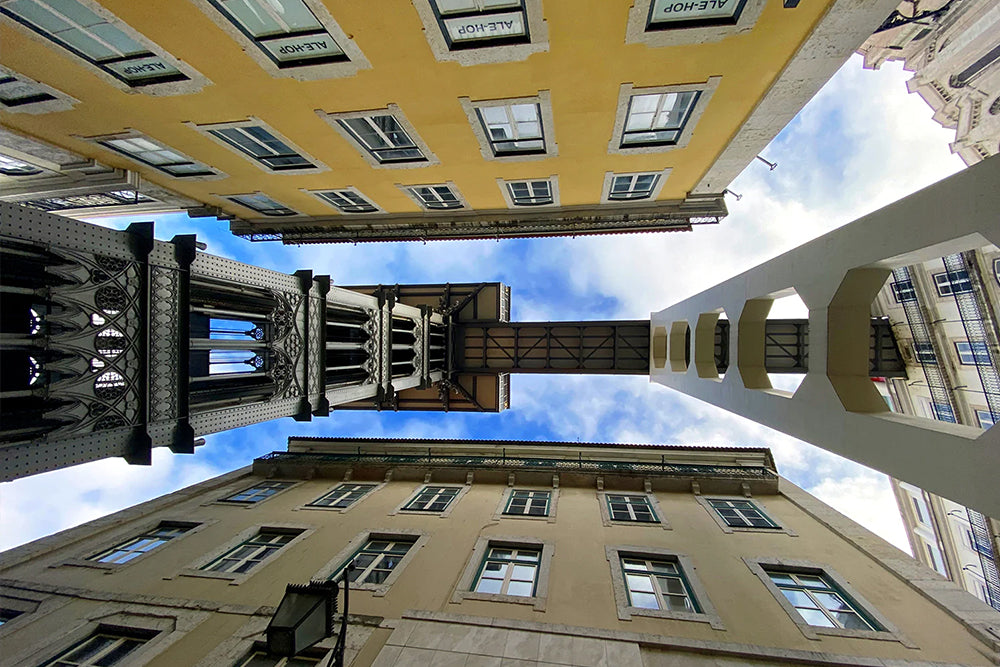
A Lisbon walking tour: from historic to modern architecture
Share
 To celebrate our new Modern Lisbon Map, here is a walking tour curated by map author Elisa Pegorin, guiding you between five of the buildings on the map – with some shops, a cafe and some heritage sites along the way. The map provides many afternoons of exploring different areas of the city. This one takes you from the Baixa/Chiado district, through the politically historic Praça do Município, to the Ribeira das Naus riverfront and culminates at the Lisbon Cruise Terminal. This walk should take you around an hour or so at a leisurely pace.
To celebrate our new Modern Lisbon Map, here is a walking tour curated by map author Elisa Pegorin, guiding you between five of the buildings on the map – with some shops, a cafe and some heritage sites along the way. The map provides many afternoons of exploring different areas of the city. This one takes you from the Baixa/Chiado district, through the politically historic Praça do Município, to the Ribeira das Naus riverfront and culminates at the Lisbon Cruise Terminal. This walk should take you around an hour or so at a leisurely pace.
In true Lisbon tourist style, our starting point to this architectural tour is the Santa Justa Elevator. The decorative neo-gothic wrought iron 19th century lift was originally powered by a steam engine and built as an innovative connection between the Baixa and Chiado areas, otherwise connected by a steep climb. This tourism highlight (which can get very busy during peak times) was designed by Raoul Mesnier de Ponsard who studied under Gustave Eiffel. The elevador officially opened in 1902. It was renovated and modernised in 2006.
The bottom of the elevator is at the end of Rua de Santa Justa (in Baixa), and the 45m ride in a polished wood cabin takes you up to a viewing platform and a 25m walkway connecting to the higher Largo do Carmo and the ruins of the 14th century Carmo Convent (in Chiado). The upper landing of the Santa Justa Lift, as well as a series of balconies and terraces close to the Carmo Convent (the Terraços do Carmo), are all designed by the celebrated Portuguese architect Álvaro Siza Vieira.

Above: The Carmo Convent. Photograph: Aleksandr Zykov
These interventions were commissioned in response to the need to rebuild the area after the devastating 1988 fire that destroyed 18 buildings in the area, many of them 18th century, causing two deaths and losses to hundreds of homes and jobs. Yet, Lisbon is a city that has innovated in moments of reconstruction – the earthquake of 1755 resulted in the building of what is considered the first modern city of Europe – and this was one of them.
Krus Abecasis, the mayor of Lisbon at the time, commissioned Siza Vieira to rethink and reconstruct the Chiado area, resulting in these respectful yet modern urban additions. The interventions include the Baixa-Chiado metro (opened 1998) with its curved interior caves covered in white tiles and escalators providing an alternative way to tackle the steep transition between the lower Baixa and upper Chiado districts.

The geometric pavement of the Praça do Município designed by writer and artist Eduardo Nery in 1998
A few minutes walk from the Chiado entrance to the metro, along Rua Garrett you will come across the atmospheric and ornate cafe A Brasileira do Chiado where you can have a special blend Brazilian coffee and a Portuguese/Brazilian fused snack alongside a bronze sculpture of Fernando Pessoa, famous Portuguese writer and poet. The cafe was founded by Adriano Telles, a former Portuguese emigrant in Brazil who married the daughter of one of the largest coffee producers and returned to Portugal to set up the cafe, which became a haunt for revolutionaries, artists and intellectuals in the early 20th century, including Pessoa. The decorative Parisian-inspired facade and interior was designed by architect Manuel Norte Júnior.
Also check out the eclectic antiquarian bookshop Livraria Sá da Costa on the corner, Burel Chiado interiors on Rua Serpa Pinto for beautiful Portuguese wool and A Vida Portuguesa on Rua Anchieta for authentic traditional wares.


Above: City Hall, Praça do Município. Photograph: Biblioteca de Arte / Art Library Fundação Calouste Gulbenkian. Below: Praça do Município. Photograph: Azchael
Museu do Dinheiro / Money Museum by Gonçalo Byrne, João Pedro Falcão de Campos, located on Praça do Município
Find your way to the Praça do Município (either via Rue Áurea from Baixa or Rue Nova do Almada from Chiado). You’re on the edge of the Pombaline area, a UNESCO World Heritage site, the heart of the Roman city, which was reconstructed after the 1755 earthquake by Marquis of Pombal and reorganised into a grid, creating the first modern Western city. Enjoy the square once you reach it with the City Hall building (open to the public for visits on the first Sunday of the month) and geometric pavement designed by writer and artist Eduardo Nery in 1998. It is here that the monarchy of Portugal officially ended and a new republic was declared on October 5th 1910, a national holiday which sees this square full of celebrations.
Our next destination though is the Museu do Dinheiro / Museum of Money, which occupies the former (now deconsecrated) Church of São Julião, a late-Baroque masterpiece of the 1800s. The building was restored and renovated into a cultural space by architects Gonçalo Byrne and João Pedro Falcão de Campos between 2009 and 2012. The project includes an elegant mix of conservation, repair, restoration, reconstruction and renovation, employing local and traditional lioz stone. The museum explores the history of money – from pre-monetary currency to banknote and coin production and the history of Banco de Portugal (which owns the buildings and the museum).
The historical facades of the building and its neighbours have been preserved, yet the inside has been opened up into one cohesive and unified space with new concrete structures for safety and modern accessibility. The social interior has a public cafe, museum shop, education spaces and a conference room. In the former church’s crypt, the last piece of Lisbon’s medieval wall dating to the 1200s, discovered in 2010, has been preserved as an archaeological artefact.
Ribeira das Naus. Câmara Municipal Lisboa
Ribeira das Naus Waterfront by Proap
Cross the Praça do Município and take a right down Rua do Arsenal. Lisbon’s courthouse is on your left. Take the next left and follow Av. Ribeira das Naus towards the sea. When you reach the Quiosque Ribeira das Naus, where you can sit for a drink and enjoy the view, you’ll be on the Ribeira das Naus riverfront path. This area was once a naval shipyard, used for centuries to build Portuguese ships and in use for most of the 20th century – though it became neglected and an eyesore for the city.
In 2009 it was decided that due to its strategic position in the city, historical meaning and proximity to the River Tagus, the area needed to be redeveloped. It was designed by Proap, a collective of landscape architects, architects, engineers and artists led by Lisbon-born João Nunes, into a new piece of public pedestrian infrastructure combining historical artefacts of the shipyard’s past, revealed in an archaeological dig in 1990, with contemporary design.
The pathway connects the Cais do Sodré station and ferry port to the west to the Praça do Comércio to the east. Take a left (walking east) when you reach the riverfront and as you walk, imagine Lisbon’s role in forging the establishment of globalisation as a centre for shipping routes. You’ll shortly emerge onto Praça do Comércio and see the grand gateway to the Pombaline city, the Arco da Rua Augusta.


Above: Praça do Comércio. Photograph: DisconnecTomas. Below: Photograph: Diego Delso
Lisbon Cruise Terminal by Carrilho da Graça Arquitectos
Continue walking up the Tagus. To your left is the Alfama area of the city and to your right up ahead you will soon see the Lisbon Cruise Terminal up ahead, a dynamic modern volume built in 2018 and designed by Portuguese architect João Luís Carrilho da Graça and his studio. It takes the form of a seemingly floating white concrete and cork pavilion with glazed facades and surrounding elevated promenades for people to infiltrate and visually explore the surroundings. These gradually lead up to the rooftop, created as a stage to connect the river and the city. There is an underground car park, luggage delivery at ground level, and passenger check-in and lounges, plus a public cafe on the upper level.

All uncredited photography by Stefanos Antoniadis for Modern Lisbon Map.
Explore more architecture with our Modern Lisbon Map available now. Read more walking tours in our news section.


